15. Leaders
Focus: This section explains the role of leaders and how they affect ground and air operations.
Key Points:
- Constraints on which leaders can command which HQs
- The impact of the various leader ratings on the game
- How leaders at different points in the chain of command affect unit performance
- Leader promotion and dismissal
Leaders play an important role in Gary Grigsby’s War inthe East 2. Every headquarters unit (with the exception of naval and rail repair units) has an assigned leader that commands and influences all units attached to that HQ, to include attached HQ’s and their attached units.
Each leader has a rank and designations that together determine what level and type of HQ unit they can command.
They also have leadership ratings that affect a wide range of game functions, from their ability to be promoted or avoid dismissal and a possible firing squad, to their ability to influence the morale, fatigue, movement points, attachment costs, combat value and combat performance of attached units under their command.
15.1 Leader Designation
Leaders are given a designation that determines the maximum level of headquarters they can command (21.11.1). Some will only be able to command Corps and Army/Air Army headquarters (Type 3 and 4 HQ units). Others can command Corps, Army/Air Army, and Army Group headquarters (Type 2, 3 and 4 HQ units). At the highest level, leaders can command Corps, Army/Air Army, Army Group and High Command headquarters (Type 1, 2, 3 and 4 HQ units).
A leader may not be placed in command of a headquarters unit that is at a higher level than his Max Command level. This maximum command level cannot be changed by promotion to a higher rank.
The Optimum rank for each command is summarized in the below table. An exception is that for air HQ units, the rank required to command the HQ is one lower than that of other HQs.

15.2 Leader Command Restrictions
Leaders may be restricted as to what kind of headquarters unit they can command. The restrictions include ground only, SS only, air and ground, and air only. German SS headquarter units may only be commanded by a SS leader. In addition, a SS leader cannot command a non-SS headquarters unit.
15.3 Leader Ratings
There are seven leadership ratings, Political, Morale, Initiative, Administration (Admin), Mechanized (Mech), Infantry, and Air, with the last three collectively referred to as combat ratings.
Leadership ratings range from one to nine.
15.3.1 Political Rating
The political rating affects the cost to replace the leader, as well as the probability that the leader will be promoted for victories or dismissed for defeats. Though the actual admin cost is based on the differential in political ratings between a leader and the leader in the next higher headquarters, generally, the higher the political rating, the greater the cost in admin points to replace a leader.
A high political rating also decreases the chance that the leader will be dismissed and possibly executed due to a poor win/loss ratio.
In addition, a leader with a high political rating will have a greater probability of being promoted, all other things being equal. A low political rating will have the opposite effect on cost of replacement and chance of dismissal or promotion.
15.3.2 Morale Rating
The Morale leader rating is used for determining unit combat value in battle, determining win/loss credit, adding or recovering fatigue in the unit’s ground elements, and rallying routed units.
15.3.3 Initiative Rating
The Initiative leader rating is used for determining the actual number of movement points a unit will have during the turn, the ability of ground elements to fire and to hit during combat, the ability of support units and combat units in reserve status to commit to a battle, and the ability to reduce casualties by turning a low odds hasty attack into a reconnaissance in force.
Equally leaders with an initiative rating of more than 5 are more likely to halt a poor odds attack at a greater range, thus reducing overall attacker losses.
15.3.4 Administrative (Admin) Rating
The Admin leader rating is used for determining the actual number of movement points a unit will have during its turn, checking for repair of damaged aircraft and ground elements and determining fuel and supplies wastage as a result of air missions.
Admin checks are specifically affected by the actual number of support squad ground elements in the leader’s HQ (21.11.7). The effect of this is proportionate to the number of missing squads.
15.3.5 Combat Ratings
Mechanized (Mech) and Infantry Ratings: These ratings are used to determine the overall combat value of units under a HQ, as well as the ability of the ground elements in the units under their command to be able to fire and to hit opposing ground elements. Successful rating checks will increase combat value and improve the chance of ground elements to both fire and to hit.
Mech ratings apply to motorized units and the infantry ratings to non-motorized.
Air Rating: For air leaders, a successful air combat skill check will result in more ready aircraft from an Air Group participating in a particular air mission.
15.4 Changes in Leader Ratings
Based on the number of wins compared to losses (19.6 and 23.11), leaders may see some of their skill ratings increase. Administrative, initiative, mech, infantry, and air ratings can only be increased if they are currently less than six.
Only air leaders in command of air headquarter units can increase their air rating. Mech and infantry ratings can only be increased for leaders in command of non-air headquarter units. Political and morale ratings can only be increased if they are currently less than eight. The naval skill rating cannot be increased.
The chance of increasing a skill rating becomes more difficult as the type number of headquarters unit the leader commands decreases. For example, a leader in a High Command (Type 1) command will have a much more difficult time increasing their skill rating than a leader in command of a Corps (Type 4).
Leaders check to see if any of their ratings increase once each turn during their side’s logistics phase.
15.5. Leader Rating Checks
Leader ratings can have an impact on virtually all actions taken by units; to include both the logistics and air planning, execution and ground phases of the turn.
Leaders conduct thousands of checks using one or more of their ratings for everything from combat value (CV) determination, many steps in the supply and logistics system and admin and morale checks for most units. In turn the infantry or mech checks figure prominently in ground combat, air rating checks are made for every air mission.
15.5.1 Leader Rating Check Procedure
Each leader rating check is essentially the computer generating a Random(x) value where if the result is less than the leader rating then the check is passed, but if the result is greater than the rating otherwise the check fails. Leaders of headquarters units where the number of attached units exceeds the command capacity (21.11.3) will have their chances of making the leader rating check reduced with the more excess units, the less the chance of a successful check.
In addition, the chances of passing admin checks is increased as the number of support squad ground elements in the HQ unit of the leader conducting the check increases.
For a corps commander, within their command capacity, the basic chance to pass a given check is their relevant leader score divided by 10. So a leader with a 6 for admin has a 60% chance of passing a given test.
15.5.2 Leader Rating and Chance to Pass a Check
The chance to pass a check is dependent on how a unit reports to the chain of command. The expectation is that Axis units will report to a Corps HQ and that, after August 1941, Soviet units will report to an Army HQ.
In this case, the chance for the immediate commander to pass a given test is their relevant rating divided by 10.
Note that all HQs, regardless of level, can only provide leadership to units that directly report to it over 5 hexes. So an Axis unit reporting to the OKH must be within 5 hexes or is treated as being out of command range and in this case the notional command range (21.11.4) of a higher level HQ is ignored.
However, Soviet units reporting to an army up to the end of November 1941 will have a lower chance to pass any leadership test to reflect the problems with command and control the Soviets faced in the early stages of the war. At this stage, the base chance for all such leadership tests is 10+2. From any turn starting after the 1 December 1941 Soviet units reporting to an army HQ are treated as if they reported to a corps (i.e. the base chance to pass a leader test is 10).
If a unit does not report to a Corps (Axis) or Army (Soviet) there are penalties to reflect the unusual assignment of combat units.
If the command exceeds its command capacity (21.11.3), in other words if it is directly controlling too many combat units, then the base chance to pass a given check will increase by 1 for every command point in excess of command capacity. Thus a HQ with a command capacity of 8 and controlling units costing 11 command points would use 10+3=13 as its base rate for any check. This figure may be further amended according to the rules above and distance to the unit under consideration (15.5.4).
The base chance to pass a test will also be modified according to the range from the combat unit to the headquarters unit for most checks.
If the immediate commander fails a check, then the next commander in the chain will be checked and may allow the unit to pass.
15.5.3 Chain of Command Rating Checks
If a leader fails their rating check, the leader of the next higher headquarters unit in the chain of command will then conduct the check, but with the base value of the check doubled.
Each failed check will in turn result in the leader of the next higher headquarters in the chain of command conducting a check with the base value doubled each time until the leader of the High Command headquarters unit in the chain of command succeeds or fails the check.
Note that the number of possible checks and the number of times the base value is doubled is dependent on where the unit is attached.
For example a German unit attached directly to OKH (High Command headquarters unit) will have one leader check at the value of 10+2. The same unit attached to a Corps could have up to four leaders conduct the check at the Corps, Army, Army Group and OKH levels.
In this case, the base value for such higher leaders will be amended according to the level of command the unit reports to, as:

The Soviet structure up to the withdrawal of the Corps HQs in August 1941 is one where some units might report directly to a corps and others to an army. In that case, the rules are:
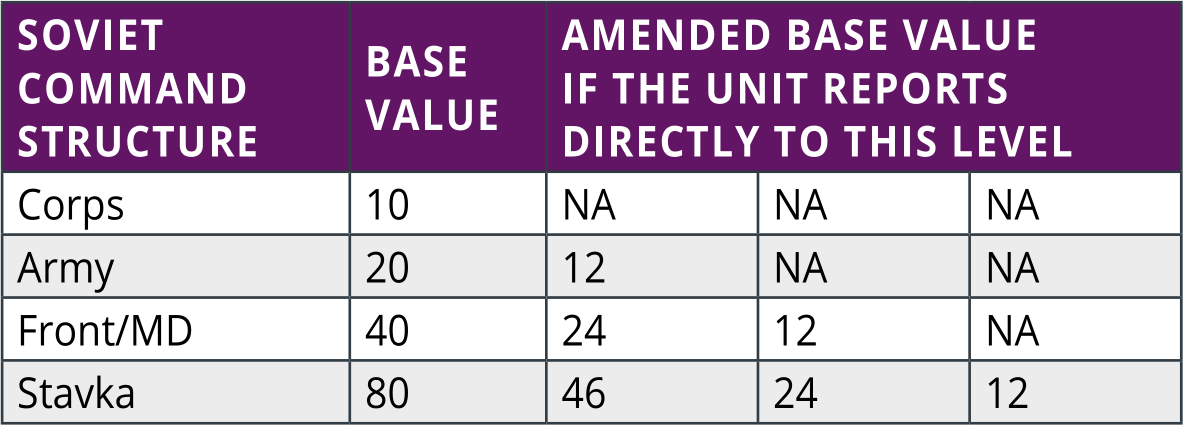
Up to the end of November 1941, the Soviet structure is one of Army-Front-Stavka but the values change as:

From December 1941 to the end of the war, the values and structure are:

Note that any units that report to one of the Airborne Corps will use the Axis table to determine their leadership rolls.
Examples:
- If a German unit reports to a Corps in the normal command structure and each leader has an admin rating of 6, the chance to pass any single test is:
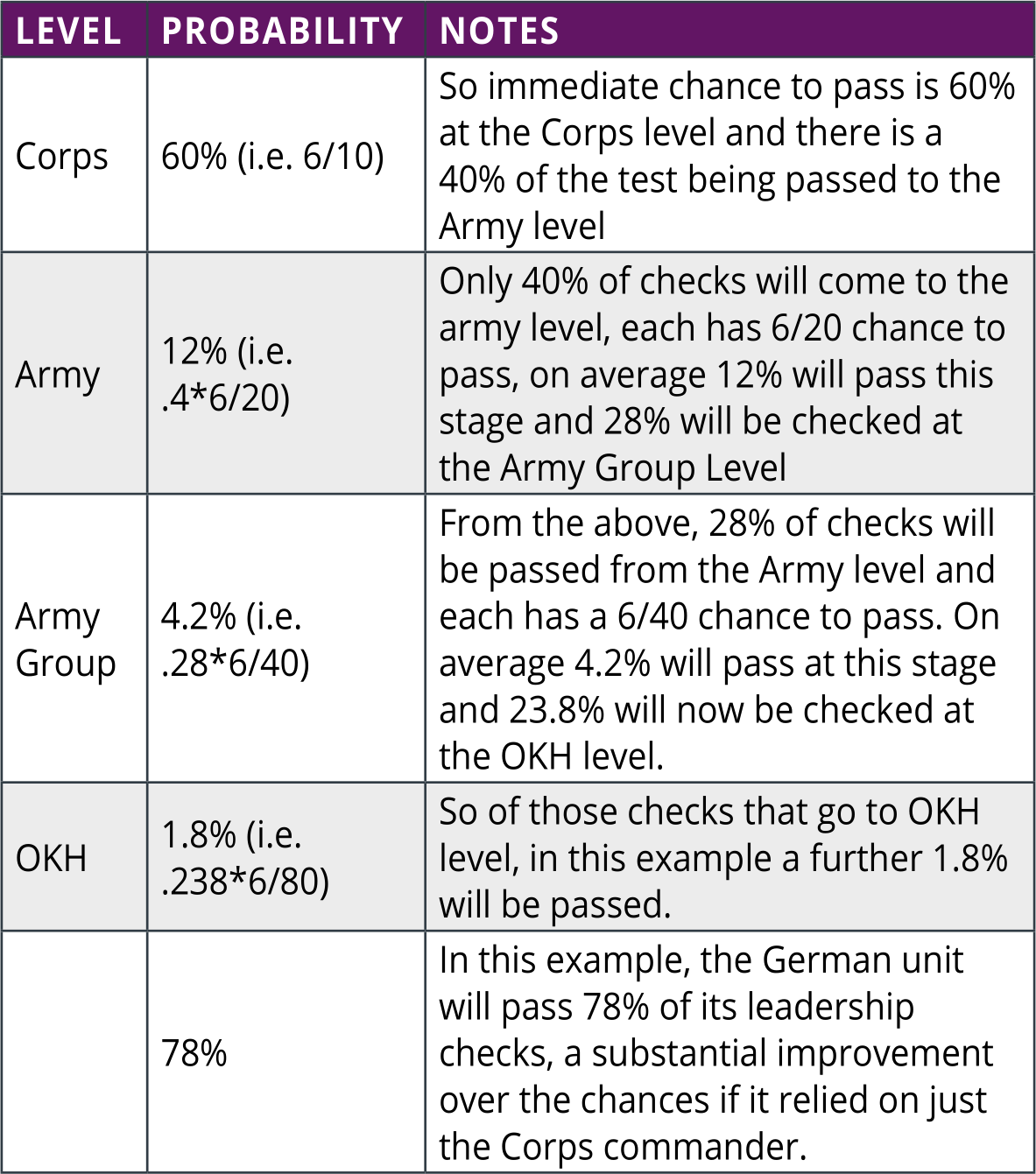
Note – for simplicity this example uses the same leadership value at each stage but for example a leader with an admin score of 8 in the Army Group would increase the chance to pass that step to 5.6% and the overall chance to pass the test to 79.3%.
- A Soviet unit reports to a normal Combined Arms Army in 1942, again assume that all the leaders in the chain have a base value of 6:
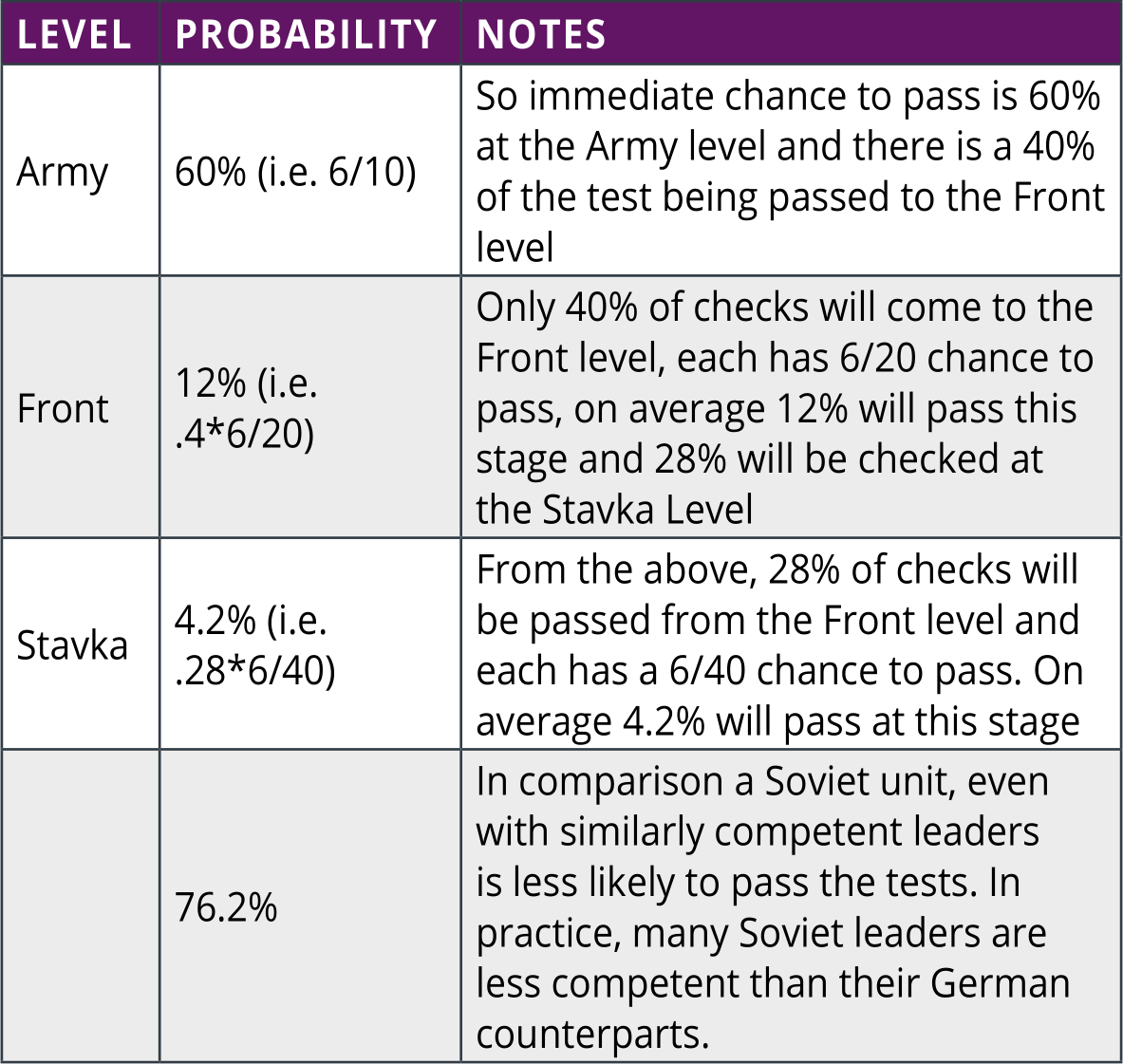
- A Soviet unit reports to a normal Combined Arms Army in October 1941, again assume that all the leaders in the chain have a base value of 6:
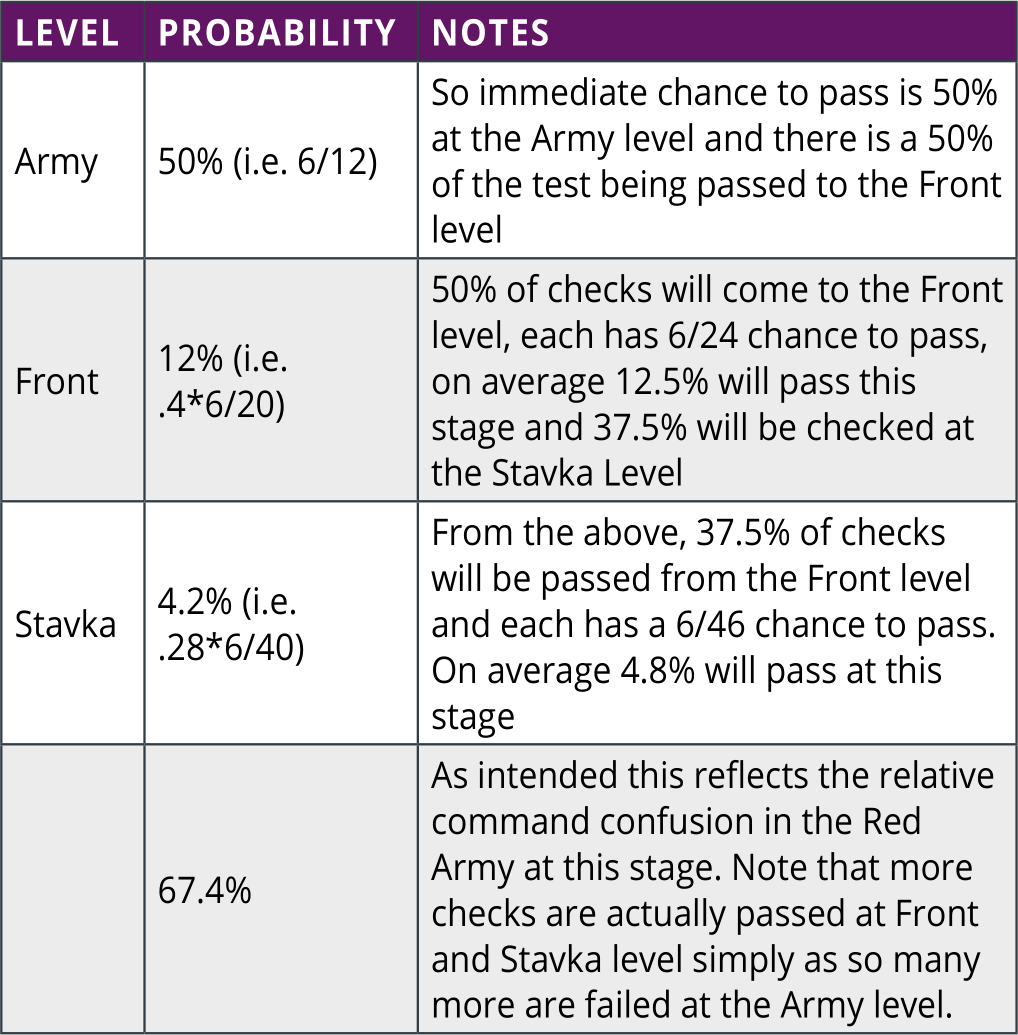
From these calculations it is worth noting that the Soviets gain from better commanders at the Front/ Stavka level as more tests will be passed to that level. This will be compounded as even late in the game, many Soviet army commanders will have low ratings for some of their leadership values.
15.5.4 Command Range Modifier
A command range modifier is applied to leader rating checks conducted by leaders in all headquarters units to which the unit involved in the chain of command, to include the HQ unit to which the unit is directly attached.
Morale leader rating checks are exempt from the command range modifier.
Each level of headquarters unit has a designated number that the range from it to the unit is divided by to get the modifier after first subtracting five from the range to the HQ units, with the value never set below zero. This means that tracing five or less hexes to any HQ or less than 91 hexes if to an air command HQ results in no range penalty.
The range effect depends on the level of the HQ unit, so that higher level HQ units can be located further away and still influence the combat units under their command. The range modifier interacts with the chain of command checks above.
Note that the range used for this test is the distance in hexes minus five. So an Army HQ that is within 5 hexes of the unit will face no range penalty. The modifiers are as follows:
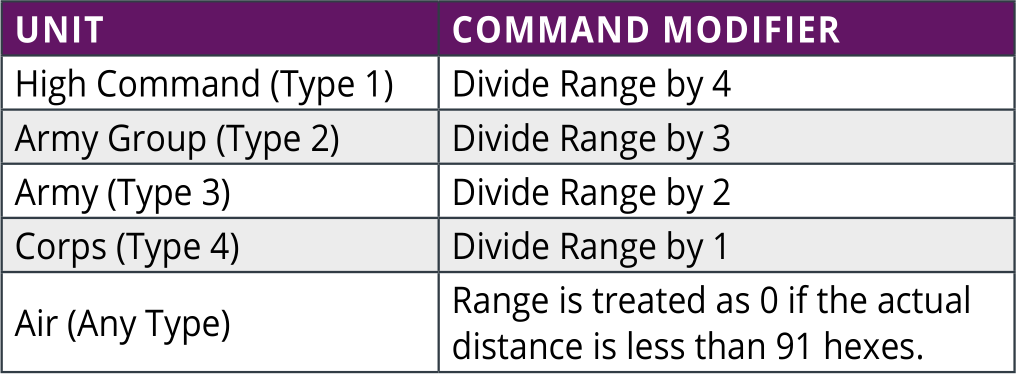
For example, if the leader of a German Army HQ unit that was 15 hexes away from a unit was conducting an initiative check, 5 (i.e. (15-5)/2) would be added to the random number value. The impact of this can be shown using the first example in section 15.5.3.
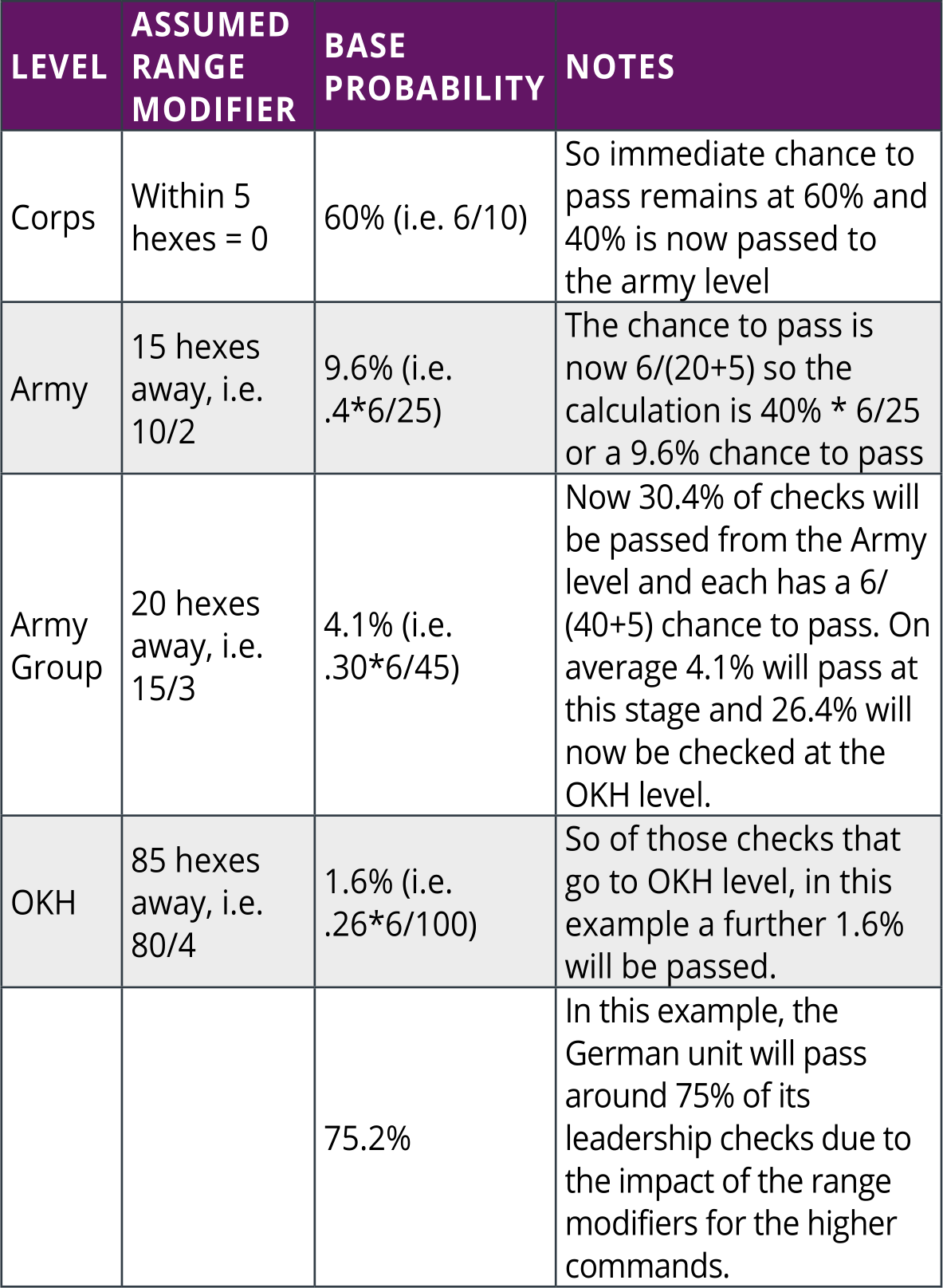
A HQ that is outside its command range will not allocate either its leadership bonus or support squads (21.2.2) to combat units under its command.
Play Note: While the effect of range on leadership effects is relatively minor, it can be enough to make a critical difference. It is suggested that higher commands are deployed on the map so they are closer to the crucial sector of their command. So the Army HQ is closer to the most important Corps HQ, Army Group HQ closer to the most important Army and so on.
15.5.5 Comand Range Exceptions for Leader Checks
Parachute or Air-Landing Combat Units that are attached to an HQ that contains the name Airborne, Paratroop or Fallschirm are considered to be only one hex from their attached HQ unit and all higher level HQs in the chain for the purposes of leader checks. This prevents units conducting an airborne landing from suffering a leader penalty as long as they are attached to an appropriate airborne type HQ unit.
15.5.6 Leader Rating and Command Reorganization
If a unit shifts to a new HQ then that HQ’s leader will have at least a -1 malus on their leadership value for any administrative rolls during that turn. If the new command also reports to a different higher command then an additional -1 malus will be applied to the corps/army commander’s administrative value.
For example, a German infantry unit moves from one corps to another in the same army. The new Corps leader has -1 on their administrative score. If that new corps reported to both a different army and a different army group, the net malus will be -3 on the administrative value of the Corps leader. If it also changed from say OKH to the Rumanian Supreme HQ, then the malus becomes -4.
15.6 Leader Promotion and Dismissal
Leaders can be automatically promoted or dismissed depending on their performance as measured in wins as compared to losses as well as their political rating. In some cases, the dismissed leader may be executed and permanently removed from the game. Players can also manually dismiss leaders and select another leader as a replacement.
A leader may be limited or restricted in the kind of headquarters they can command, to include level (Corp/Army, Army Group, High Command) and type (SS, air or ground).
15.6.1 Promotion
Leaders undergo a promotion check once each turn during their sides logistics phase. A leader is promoted to the next rank if they pass the check, which is based on their political rating and their number of combat wins and losses. Promotion will result in the zeroing out of that leader’s number of wins and losses. A leader with a max command of high command may be promoted to the highest rank if selected to command a high command HQ.
For Corps and Army headquarters units, a leader will be automatically promoted to an appropriate rank if selected. If promoted this way, the leader must make a check for each skill rating to see if it drops one point. There is less of a chance for a particular skill rating to drop if that skill rating has been previously reduced.
If a leader is killed and the computer replaces the dead leader with a leader that requires a promotion, a similar check for a drop in skills occurs.
Leaders who are promoted through the normal promotion check process do not check for a decrease in skill ratings.
15.6.2 Dismissal and Replacement
Leaders can be dismissed automatically by the computer (representing the national political and military leadership) due to a poor win/loss ratio. In some cases of poor win/ loss record dismissal the leader will be executed and permanently removed from the game rather than being returned to the leader pool. Leaders killed by execution will be noted in that side’s Logistics Phase Event Log (36.9.8) at the beginning of the ground phase. In all cases of automatic leader dismissal, the computer will automatically select a replacement and the event will be reflected in the logistics phase event log. There is no admin point cost associated with automatic dismissals.
The player can manually dismiss a leader and replace them by first selecting the leader in the headquarters unit detail window (37.2) and then selecting the dismissal cost link in the leader detail window. This will bring up the pick new leader window (37.9), which allows the player to select from a list of all eligible candidates as replacement leaders. The list is ranked by the computer based on skill ratings and the current rank of the candidate replacement leaders.
To be eligible, leaders must have the proper level and command restriction designations. Leaders can serve one level up and two levels down from the optimum rank for the HQ level.
There are variable admin costs associated with dismissing leaders. The pick new leader window, which allows the player to select from a list of all eligible candidates as replacement leaders will list the AP cost in a x + x format with the first number being the cost to bring the new leader in to the position and second being the dismissal cost for the dismissed leader.
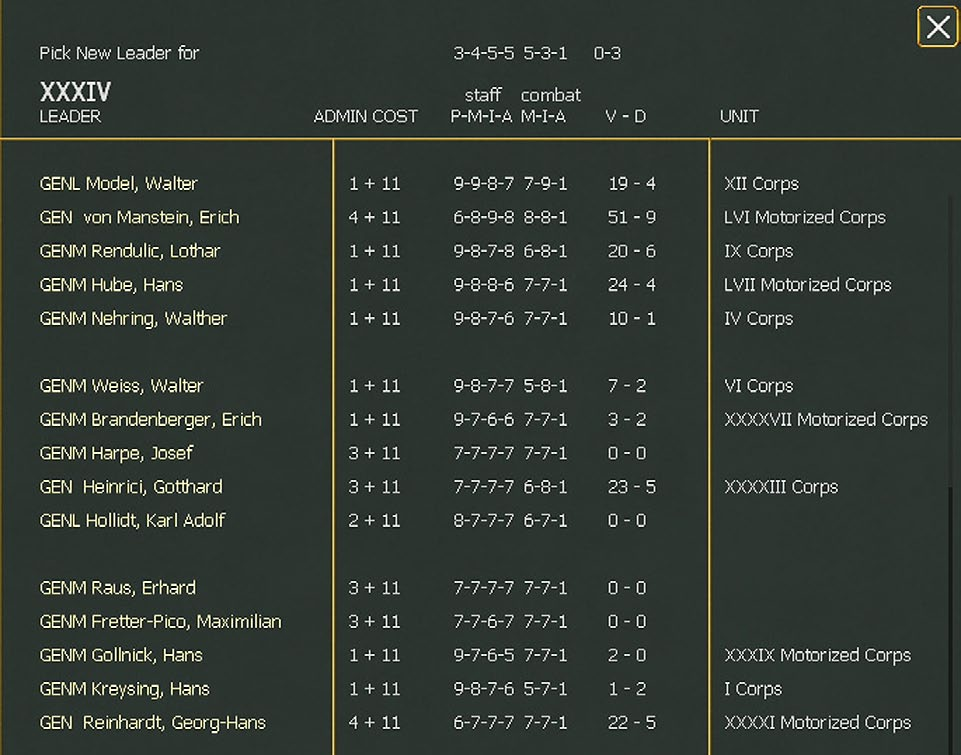
A leader with a rank one higher than the optimum rank may fill an HQ position at no extra admin cost, but leaders with a rank one lower than the optimum rank that fills an HQ position will normally require the expenditure of extra admin points. When a leader is dismissed, some leaders that are available as replacements will have less than the optimum rank to take the new position. These leaders have a P in the Pick New Leader window next to the number of admin points it will take to appoint the leader, which will usually be significantly higher than the admin points required for a leader with the optimum rank for the position.
For Army Group and High Command headquarters units, leaders with a P can be selected, however, they will remain at their current rank until they are promoted through the normal promotion process.
15.7 Battle Win and Loss Credit
A leader may be credited with one win or one loss every time a combat unit in their chain of command participates in a battle. For Air leaders, a win/loss situation occurs if an air group in their chain of command participates in an air mission that results in a set differential in losses (19.6).
In each case, this includes all higher headquarters up to the combat unit’s High Command headquarters.
For example, if the German 290 Infantry Division wins a battle then the commanders of L Corps, 18 Army, Army Group North and OKH are all credited with a win.

Wins and losses are recorded in the individual leader detail windows as well as in the unit list in the commander’s report.
When a leader earns a win or a loss, there is a chance that it will not count for promotion or skill rating increase purposes. Although the total wins and losses are displayed for the leader as described above, the actual total used by the promotion system is tracked separately and will in most cases be less than the total wins and losses shown on displays.
15.8 Death of a Leader
Leaders can be killed and permanently removed from the game due to dismissal, headquarters relocation, air attack and other enemy action. Leaders who are automatically dismissed due to poor performance (losing battles) may be executed.
A low political rating increases the chances of a dismissed leader being executed. There is a 15 percent chance that when a headquarters unit is relocated or forced to execute a displacement move, the assigned leader may be killed or captured. In either case, if the HQ is isolated the chance of the leader being killed increases to 50 percent.
There is also a very small chance of a leader being killed if their headquarters unit suffers casualties from enemy air attack, such as ground attack, air interdiction and ground support missions.
Finally, there is a small chance that leaders may be killed due to other enemy action. The probability of this occurring is related to the distance the leader’s headquarters unit is located from enemy units, with headquarters units closer to enemy units having an increased chance of having their leader killed. Any leader in an HQ that is more than 10 hexes from the enemy will have his chance of being killed reduced by two thirds.